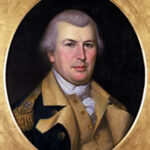A Brief History
The Quaker Oats Company was officially formed in 1901 when several American pioneers in oat milling came together to incorporate the now familiar name. In the late 1800s, each of three Midwest milling companies had independently begun to process and sell high-quality oats for the consumer – giving the American family a product that would be superior in quality to the oats sold in open barrels at general stores. In Ravenna, Ohio, Henry D. Seymour and William Heston had established the Quaker Mill Company and registered the now famous trademark. In Cedar Rapids, Iowa, John Stuart, his son Robert and their partner, George Douglas, operated the largest cereal mill of the time. Ferdinand Schumacher, known as “The Oatmeal King,” founded German Mills American Oatmeal Company in 1856 after selling oats in his Akron, Ohio, store for two years. Combining these companies after the turn of the century brought together the top oats milling expertise in the country and gave the newly formed corporation a name that – even then – was a symbol of quality and purity.[1]
Today, Quaker Oats Company is the leading manufacturer of sports beverages, hot cereals, grain-based snacks, value-added rice products, pancake syrups, cornmeal and hominy grits. In addition, the company is the second largest manufacturer of value-added pasta products and pancake mixes and is among the four largest manufacturers of ready to eat cereals.
Human Resource Planning 1990
The HR planning process used was very straightforward. It does not require a mastery of specific behavioral science or strategic planning theory. The process is represented in Figure 1.[2] Specific steps (A-E) are keyed to the chart.
A. Quaker Oats Current Status
The needs of the high-tech plastic molding plant in New York State are very different from their recently acquired orange juice processor in Florida.
B. Program Review
Adaptation of Dr. James Walker’s HR building blocks. Figure 2.
C. Corporate Business Strategies
· The need for white-collar productivity improvements to help meet ambitious earnings growth targets in a soft economy.
· Need for more intensive management development to meet the demands of international business that have been in a high growth mode.
· The need to prepare for the HR aspects of rapidly developing a new business segment.
Quaker’s strategies have remained reasonably steady for years and have been met on a relatively consistent basis. Therefore, the assessment of the internal impact was relatively straightforward. A more difficult challenge is the assessment of the external environment.
D. External Environment
– Demographics – Technology
– Economic Conditions – Regulatory Environment
– Sociological Trends – Union Initiation
A package of reading information was provided to participants who gave input to the process so that Quaker Oats might approach the effort with similar outlooks.
The analysis of external impact is not a highly refined part of QO planning process. Nor is refinement a high priority, since ther product mix and range of talent needs suggest that we could accommodate moderate disruptions or directional changes in the environment influences. The same assessment will not hold true for many companies.[3]
E. The Resulting Objectives
A summary of the principal areas covered by statements of objectives is shown in Figure 3.[4] The review process lead to a variety of reactions. Business areas which had an effective HR function for some years may have felt the objectives were not challenging enough, while some recently acquired units may view them as nearly impossible. One manager stated that the objectives seemed like ordinary “common sense”. The human resource leaders set the pace for the rest of the corporations.
Communicating Objectives
It is extremely important to communicate the HR objectives to employees whose personnel actions affect employee perceptions and progress toward their goals. There are thousands of managers who do performance appraisals. If the goals are not clearly communicated, how could Quaker Oats expect their managers to work toward them?
Strong evidence was cited for building a values-centered corporate culture. In their study they profiled 80 prominent companies.
-24 of 80 companies had a clearly articulated philosophy.
-18 of these 24 had communicated the philosophy broadly.
-All 18 companies had outstanding performance records.
Diversity Management – Strengthening Leadership & Employment
Quaker Oats has a great history of supporting the African and Hispanic American communities. From leadership to sponsorship, and from employees to vendors, their track record shows a strong commitment to enriching the African and Hispanic -American communities. In 1995 QO committed themselves further to a program to improve the recruitment, development, retention and promotion of minority managers and professionals. The program is progressing with active input from an African-American consulting firm, Alignment Strategies.
Quaker has a long standing commitment to education – funding educational initiatives within the Hispanic community. They range from early childhood education through college and vocational training. Quaker’s educational and community commitments include LULAC National Educational Service Center and the NAACP which distributes college scholarships. Quaker also supports the Hispanic Association of College and Universities and the Hispanic Leadership Conference. These contributions supplement Quaker Oats’ National Merit Scholarships for minority students.
Quaker sponsors Head Start programs, the Cities in the School program (the largest non-profit dropout prevention program in the country) and the Latino Institute supporting educational reform. Quaker contributions fund work-study scholarships in food services at Cristo Rey Jesuit High School in Chicago. As part of Quaker’s education and training out reach activities, the Company supports the Spanish Coalition for Jobs and the Hispanic Alliance for Career Enhancement.
Over the past five years, Quaker Oats has donated nearly $40 million worth of products to food banks across the country, supplying food to needy people through community-based organizations – many in the Hispanic community. Quaker also supports the Chicago Head Start Program through its Head Start Nutrition Education Program. At the Infant Welfare Society of Chicago, Quaker sponsors a bilingual nutritionist who promotes healthcare. Using Quaker funds, culinary skills course materials were translated into Spanish for the University of Illinois, Department of Human Nutrition and Dietetics.
Quaker employees are active volunteers in the community, and Quaker’s Hispanic-American employee group is a big driver. The employees participate in virtually every major community-based fund raising event in Chicago, and many across the nation.
Quaker organizes quarterly collection drives for the needy, provides Christmas product baskets for the poor, and funds “Dollars for Doers, ” a program that provides financial assistance to organizations where Quaker employees volunteer. The matching Gifts Program matches employees’ gifts to not-for-profit organizations.
Quaker Oats Company has been, and will continue to be actively involved in communities and programs where they have business interests. Quaker Oats does this not only because it makes good business sense, buy because these are the communities whose residents buy the products and represent a growing portion of the workforce and supplier base. They are also communities, which the employees work and live. Ensuring that these communities are vital and economically sound, and that their residents are well educated, is essential to the long-term success of the Company. Recruiting and Management 1993-1999
“Work flexibility,” The key to recruiting and retaining employees for at least the rest of the decade. Companies have discovered that this umbrella of programs that began, as work/family issues aren’t just employment gimmicks that let women maintain their careers and raise families at the same time. Child-care and eldercare services or subsidies, flexible hours, compressed workweeks, job-sharing, and part-time employment have emerged as some of the best tools to recruit and retain workers of both sexes.[5]
“These programs often start in companies as a way to improve morale, productivity, and absenteeism,” says Mrs. LaTonia Arnold, Recruiting Specialist, Quaker Oats Company, Chicago Illinois. “Where they end up having their greatest impact is in recruitment and retention. They provide social services at the workplace.” “The whole issue of flexibility has popped up like a neon light,” people want the ability to control their time, but still be good workers,” she says. “If workers have more control over their own destiny,” says Mrs. Arnold “they feel less stress, feel more successful in balancing work and family, and are more productive.”
Corporate thinking has changed because of the increased number of working women and a growing realization that the costs associated with such programs are actually less than the costs to a company not offering such flexible work programs. “Employees miss work when their children are sick, or they spend time worrying at work, which hampers their Productivity,” says Mrs. Arnold.
A study by the National Council of Jewish Women found that women at companies with family-responsive programs spent more uncompensated time working, worked later into their pregnancies, were more likely to return to their jobs, and were absent one-third less often than women at companies without such policies. Employers who dismiss out of hand such studies – or who question statistics that show that the cost of work/family policies is 32% of a worker’s salary compared with the 75% to 150% of salary it takes to replace a worker who leaves – should survey their own employees, says Mel Wormely, Director of work/life initiatives and diversity at Quaker Oats Co., Chicago.
Of the 1,100 Chicago-area Quaker employees who responded to a survey last year, more than half had children under the age of five or expected to have children in the near future. In addition, more than two-thirds expected to have some type of eldercare responsibility down the road.[6]
Less than one- third of its employees with children under 13 had a spouse who provides total care for their children and only 16% had a spouse who is not employed outside the home.
More important, from the standpoint of business effectiveness, 20% of Quaker’s employees said that child-care problems interfered with their ability to travel. More than 60% admitted being absent at least three days a year because of children’s illnesses, and a staggering 56% were unable to attend company-related functions or work overtime because of child-care problems. “If you want to retain key people, this becomes
Extremely important,” says Mr. Wormely. “You have to ask yourself what the impact on the company would be if you lost the services, even temporarily, of a key manager because of child-or elder-care problems. Until you present the issues to your company in these terms, they cannot link them to business strategy.” Thus, Quaker – consistently ranked as who choose to continue breast-feeding after returning to work. It subsidizes
Community dependent-care facilities, and helps employees find not only day care, but sick- childcare, after-school and summer care, and back-up care.
What’s more, Quaker employees can access School Smart, a telephone counseling service staffed by former teachers and education experts that helps parents deal with school- related issues ranging from report cards to test scores.
In what ways does a company benefit from such programs beyond the obvious advantage of less time away from the job by workers who must worry about child-or eldercare needs?
“By meeting workers’ needs, you can retain an employee’s valuable knowledge. The goal is to attract and retain people. That is the driving force behind the flexibility of our policies.” Says Mrs.Arnold.
Companies have to understand that taking care of peoples’ needs is the key to productivity. “What too many companies fail to grasp is that people can walk out the door just as quickly as they come in. You have to remember that people are your main resources, not your products or equipment. Besides, companies always ask there employees to adjust to the ups and downs of the business world. “We expect them to help us in rough times,” says Mr. Womerly, “so it is not fair for a corporation to constantly ask its people to give to the needs of the corporation if it doesn’t reciprocate, support the needs of its people. If you have a people-first philosophy, you can install passion in the workplace, and you can enhance productivity.”
Although much of the current work-flexibility emphasis is on childcare, expect programs that help with elder care to become more prominent in upcoming years. Why? With childcare, CEOs weren’t as interested because they often had wives who stayed home and took care of the children or had the money to pay for childcare.
It’s a different story with elder care. “The fact that CEOs are older may fuel the issue,” says Ms. Angela Heath, President of Health and Company, A Washington Consulting Firm. The American Management Assn. estimates that it costs a company with 1,000 employees $400,000 annually, based on absenteeism of the caregiver, not to offer elder care. Thus, she says, “elder care will be folded into the overall work/flexibility agenda.” In the future, flexible work options also will more often involve “the notion of equity and looking at the life cycle of employees’ needs,” From child care to elder care, declares Dana M. Friedman, co-director of the Families & Work Institute. “We are going to see more sophisticated flexible work options, with employees more vocal about the gaps in their coverage.” And if the recruiting, retention, and productivity arguments don’t convince employers, legal arguments will. “Supervisors are going to have to get used to the idea that they have no choice but to accommodate to the requests of their workers because of the federal Family & Medical Leave Act and its potential for lawsuits,” says Janice Stanger, group- benefits consultant at William M. Mercer Inc., Washington.
Training
Most of the training at QO is demonstrated with the mentoring or “shadowing style” where you work with a manager and watch what their job entails on a day to day basis. Another program that they utilize is the rotational program. This is where the employee participates directly in the operations of the job. Some of the programs are as follows:
Integrated Purchasing Logistics and Supply Chain Management, Customer Financial Services, Finance and Accounting Rotation Program, Brand Management, and Marketing Research. The only exception is with the Executives, who are sent off site for training. When the entire company needed training for the Windows NT, departments were sent to outside training in the classroom style. Administrative Assistants are generally the employees that are trained in a classroom style because it is computer training.
Mrs. Arnold began her career in 1988 as a temporary employee program. In 1992 after receiving her undergraduate degree in Marketing she received added responsibilities of Profit Sharing 401K. In 1994 she took on the role of Long Term Disability and 1996 she was promoted to Quaker Oats Employee Administrator. In 1998 after receiving her Masters of Science degree in Human Resource Management she was promoted to Recruiting Specialist.
HR managers are sent to the Sharm Society for Human Resource Management training four times a year. The upper management looks for them to bring new ideas back to the office. They want them to read local and national trades and newspapers, network and offer memberships to appropriate organizations.
Policies/Benefits
·. People are different. Differences create opportunity. That’s Diversity and that’s Quaker. They are committed to developing a culture that maximizes all of their employees individual talents and capabilities to consistently drive the businesses. Quaker Oats strives to provide a workplace that fosters productivitiy and inspires each employee to realize his or her fullest potential. By accomplishing this, Quaker builds a competitive advantage in the marketplace.
In an ever-changing marketplace, a successful company, such as Quaker Oats, needs to be ever improving. The New CEO, Bob Morrison has a new philosophy-“In order to be the best, we have to hire the best.” He has a background from the Military and he recruits for the line production positions. “His new attitude has ultimately changed the culture of the organization, and I think this is what he wants, it has begun the “trickle down effect” which is a good thing, says Mrs. Arnold.
A major segment of Quaker’s overall diversity management initiatives includes innovative and nationally recognized family and work-life programs, designed to promote increased productivity by helping employees balance their work and home lives. Among these are QuakerFlex (a flexible benefits program capable of being tailored to the employee’s needs), fitness and other wellness programs and a variety of flexible work schedules in a number of Company locations.
Quaker is an equal opportunity and affirmative action employer, committed to the empowerment and advancement of qualified employees without regard to race, color, religion, gender national origin, age, veteran status, physical or mental disabilities, sexual orientation, marital status or other non job-related characteristics.
– – – – – – – – – – – – – – – – – – – – – – – – – – – – – – – – – – – – – – – –
[1] www.Quakeroats.com
[2] A “No Frills” Approach to Human Resource Planning 1984, pg. 42
[3] IBID pg. 43
[4] IBID pg. 43
[5] Industry Week, “People-first policies ” pg.20.
[6] IBID, pg. 22.
References
“People-first policies ” Verespej, M: Industry Week, v242n12, 6/21/93 pg.20-22
“A “No Frills” Approach to Human Resource Planning” Lawrence Baytos: Human Resource Planning, v7n1 1984 pgs. 39-46.
www.QuakerOats.com
Quaker Oats Annual Report 1998 pg. 69.
Measuring and Managing Corporate Culture, Stephanie M. Bookbinder, Human Resource Planning, pg. 47-55. 1984.
Figure ThreeL Human Resource Objectives
I Individual Performance and Growth
Productivity Improvement – Employee Involvement
Individual Performance Against Objectives (Fair Appraisal)
Recruitment and Personnel
II Meeting Employee Needs
1. Competitive Compensation, Equitable pay opportunities
2. Comprehensive Benefits, Financial Protection
3. Employment Continuity
4. Employee Safety and Health
III Working Relationships
1. Teamwork
2. Two-way Communication (union-free status)
3. Creativity/Innovation
IV Method of Operation
1. Organization Structure
2. Employee Ownership Perspective







